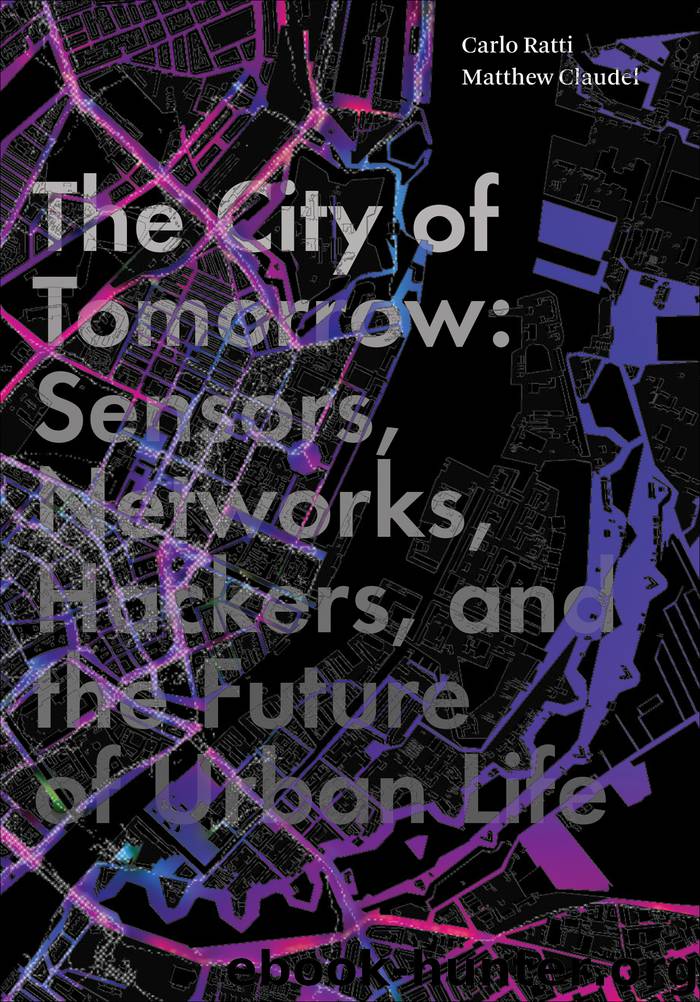The City of Tomorrow by Carlo Ratti & Matthew Claudel

Author:Carlo Ratti & Matthew Claudel
Language: eng
Format: epub
Publisher: Yale University Press
Published: 2016-08-12T16:00:00+00:00
Plan of Brasília by Oscar Niemeyer and Lúcio Costa
Building a city entirely from scratch allows the planner to selectively use only the most advanced technology of the time. Recalling the long-standing race for urban efficiency, the masterplanned city of Brasília was designed in 1956 by two Brazilian architects and planners, Oscar Niemeyer and Lúcio Costa. The city is defined by state-of-the-art transportation technology—the automobile. (Seen from above, however, Brasília looks like an airplane.) Car culture dominates in a city composed almost entirely of highways. The original plan, shown here, contains no sidewalks or traffic lights, and different urban functions are separated into distant zones. The city is an important political and economic center, but it is almost without character or life, earning the city its nickname “ilha da fantasia,” or fantasy island, in Portuguese.
Schemes that targeted public transit exacerbated societal shifts toward personal mobility. What has come to be known as the “Great American Streetcar Conspiracy”—although the conspiracy remains unproven—choked public transit in cities across the United States during the 1940s and 1950s. A group of automobile companies, allegedly led by General Motors, implemented programs to purchase streetcar and electric train systems and subsequently dismantle them. The project was brought to the public spotlight by a whistleblower, Commander Edwin J. Quinby, in 1946, with accusations that there was a deliberate scheme to shift the United States toward automobile dependency. Although the companies were never legally prosecuted under antitrust regulations, the affair unambiguously contributed to the same vicious cycle: cities became increasingly hostile to pedestrians, and cars became increasingly necessary.3
The automobile became a symbol of the American dream, embodying success, individualism, and empowerment. A personal vehicle could satisfy any whim or fancy—unfettered by train schedules or bus routes, cars promised mastery of space and time. The allure of the automobile, particularly in mid-century America, was nothing short of pure freedom. The same attitude rapidly permeated—to varying degrees—most of the industrially developed and emerging world.
In almost perfect synchrony with the rise of automobile glamor Los Angeles sprang up out of the Southern California desert. With seemingly limitless space and wealth to match, the city spread itself from the ocean in the west to the Inland Empire in the east, resulting in a distinctive and disaggregated urban form. The pattern was so characteristic that the urbanist and architectural critic Reyner Banham made a pilgrimage from the United Kingdom to define and study it. He sought to understand not the signature buildings of the city but the urban fabric and its genesis—and to do that, he took to the roads. “Like earlier generations of English intellectuals who taught themselves Italian in order to read Dante in the original,” said Banham in a colorful documentary, “I learned to drive in order to read Los Angeles in the original.” What he found outside the windows of his car was a city built of four “ecologies”: Surfurbia (the beach), Autopia (the freeways), the Plains of Id (the flatlands), and the Foothills. “The point about this giant city,
Download
This site does not store any files on its server. We only index and link to content provided by other sites. Please contact the content providers to delete copyright contents if any and email us, we'll remove relevant links or contents immediately.
The Secret History by Donna Tartt(18951)
The Social Justice Warrior Handbook by Lisa De Pasquale(12170)
Thirteen Reasons Why by Jay Asher(8848)
This Is How You Lose Her by Junot Diaz(6837)
Weapons of Math Destruction by Cathy O'Neil(6220)
Zero to One by Peter Thiel(5736)
Beartown by Fredrik Backman(5682)
The Myth of the Strong Leader by Archie Brown(5461)
The Fire Next Time by James Baldwin(5386)
How Democracies Die by Steven Levitsky & Daniel Ziblatt(5175)
Promise Me, Dad by Joe Biden(5117)
Stone's Rules by Roger Stone(5053)
A Higher Loyalty: Truth, Lies, and Leadership by James Comey(4909)
100 Deadly Skills by Clint Emerson(4882)
Rise and Kill First by Ronen Bergman(4741)
Secrecy World by Jake Bernstein(4703)
The David Icke Guide to the Global Conspiracy (and how to end it) by David Icke(4658)
The Farm by Tom Rob Smith(4468)
The Doomsday Machine by Daniel Ellsberg(4452)
